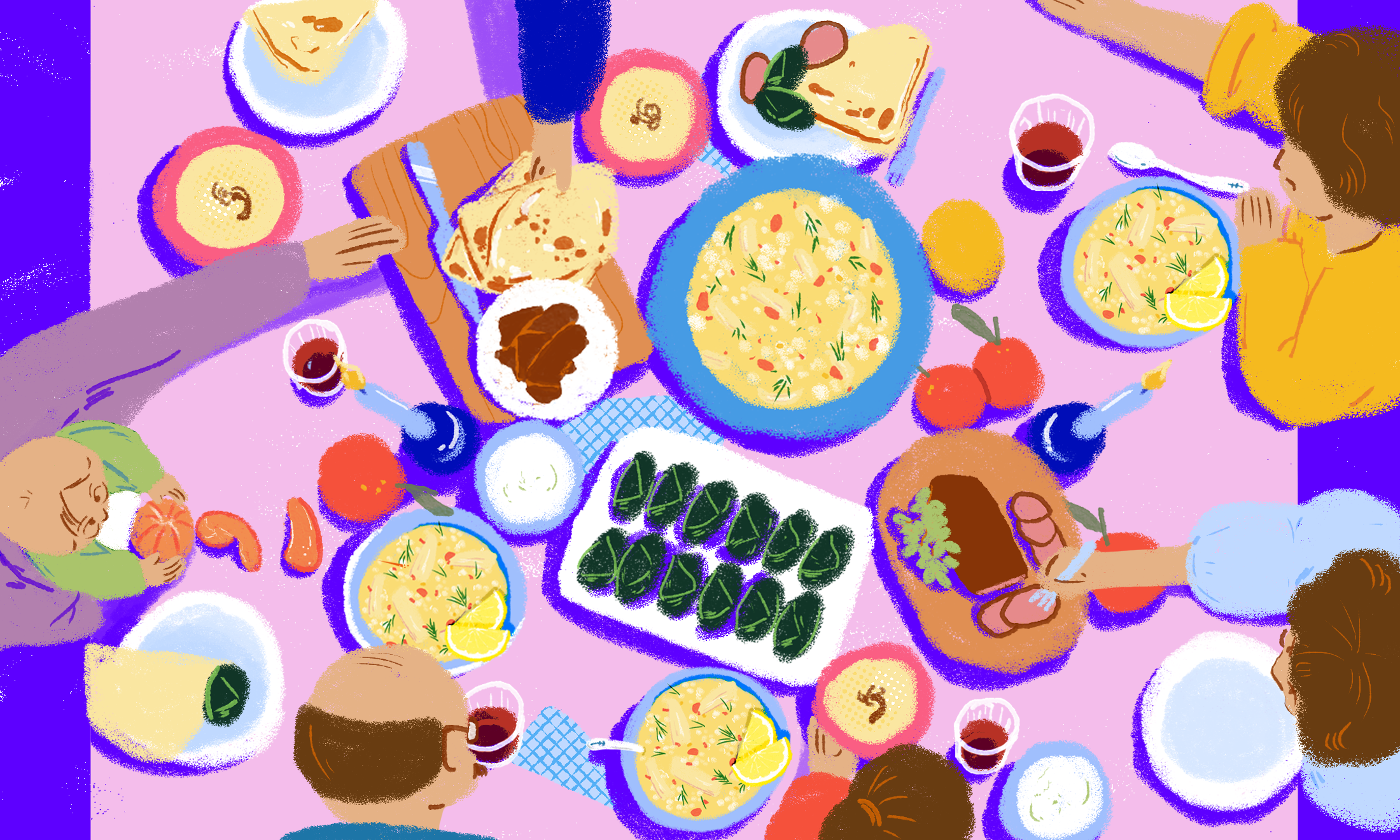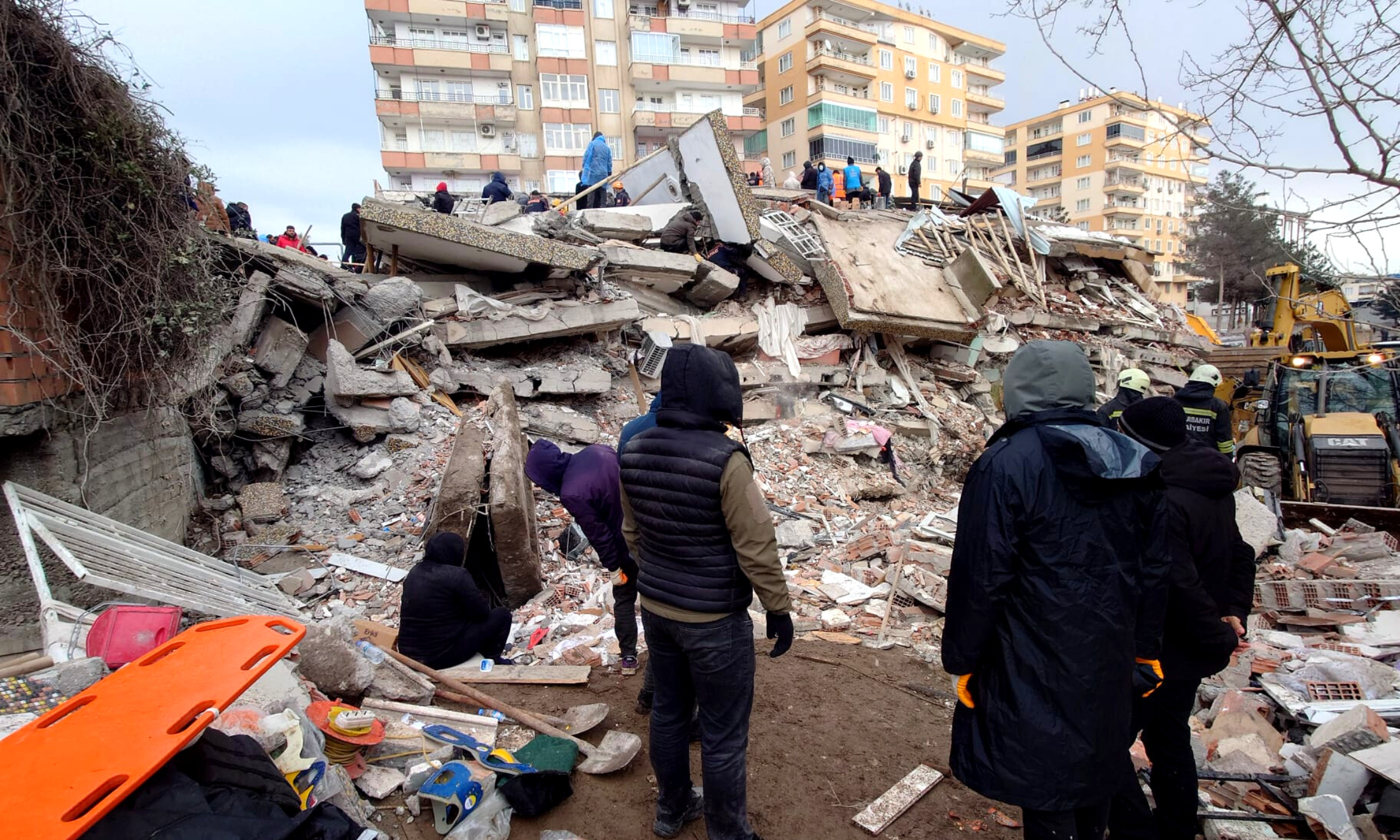Food from across the border: the Cypriot generation exploring a new identity
What can food stories from the last divided capital tell us about what it means to be Cypriot?
Despina Christodoulou
27 Nov 2021

Illustration by Heedayah Lockman
Cousin Helen’s kitchen table is barely visible beneath bowls, sheets of folded kitchen towel, a saucer of sliced lemons, seeded bread in a paper bag and a giant saucepan of avgolemono soup. “There’s trachana for you, Despina,” she says. My brothers Alex and Petros roll their eyes. There’s a debate amongst Cypriots about avgolemono and trachana. It’s like Coke versus Pepsi except it’s about two unassuming soups. Avgolemono is Coke. Alex lifts the saucepan lid to release lemon-scented steam. Inside the soup, there are chicken legs with grey ankles, dimpled skin yellow from the lemon.
Helen sets a second saucepan down and we overlap the table mats to make it fit. Trachana is no better looking. The ingredient it’s made with is one of the oldest in the Eastern Mediterranean; goat’s milk combined with cracked wheat flour, fermented in earthenware containers and left to dry out in the sun. The soup it makes is off-white and textured, coy about the exquisite comfort contained within. Helen adds grated tomatoes, vermicelli and – 10 minutes before the soup is finished so they melt just slightly – cubes of halloumi. Hot, salty, a little sour, with the edge taken off by the sweet blush of tomato, trachana is a food that touches my soul.
Turkish Cypriots call their version of this soup tarhana, though I use the term ‘version’ lightly – the two soups are identical. Trachana/tarhana is a defining Cypriot food and one of many that highlights the overwhelming similarities between the two communities sharing the island. Most people in the UK can confidently list a handful of Greek food (souvlaki, pitta, tzatziki) and Turkish food (dolma, baklava, köfte) but what about Cypriot dishes? What does it even mean to be Cypriot? For myself and many living in the diaspora, one of the most commonly asked questions is “yeah, but what kind of Cypriot are you? Which side?”
“Most people in the UK can confidently list a handful of Greek food and Turkish food but what about Cypriot dishes?”
I spoke to a handful of people in the community in an effort to understand how this misplacement of their identity and culture affects them, and what we can learn from our shared cuisine. Maria Christodoulou, a civil servant from Enfield, tells me that she understands why people ask. “Cypriot identity is so complex,” she explains, “I’m trying to self-identify as just Cypriot because I want that to be a whole thing. I struggled with it growing up, it felt like it wasn’t enough.” Despite previously identifying as Turkish Cypriot, Omar Suleyman, an artist from South London, has made the same decision to drop the prefix. “We grew up being told that Cypriot wasn’t enough,” he echoes.
Cypriot identity is certainly complex. The Turkish invasion of Cyprus in 1974 forced Greek and Turkish Cypriots to polarise. On my dad’s 16th birthday, he fled to a refugee camp and eventually to the UK, never returning to his home village. He was among thousands of Cypriots from both communities who were forced to seek asylum. Those who stayed were segregated by the Green Line, a man-made border that today forms the last divided capital in the world.
My dad would talk often, pulling a toothpick out of his mouth to punctuate his sentences, about how his ancestors had sown the soil that his home was built on. He’d sat on the roof of that same home the night the village got electricity for the first time and watched the tiny yellow bulbs flicker on and light up the streets. He could return with a visitor’s pass but he didn’t want to. I would be lying if I didn’t acknowledge the imprint that his PTSD left on me. Trying to find my identity almost 50 years later, through his lens, is like trying to taste the water in a rose cordial. It’s hard to experience impartiality, a testament to the enduring strength of divide and rule politics.
“There was no embarrassment like spotting a battered bag chugging down the airport conveyor belt that you knew to contain an entire tree worth of apricots”
Even so, I grew up near north London’s Green Lanes, home to one of the largest populations of Cypriots in the UK. With a curiously similar name to the Green Line, the street tells an entirely different story. When I speak to Aziz Kemal, an actor who grew up in the same neighbourhood as me, we spend a solid 10 minutes on the ‘who’s who’ of our childhoods. It’s a conversation reminiscent of our elders in Cyprus exchanging village names by way of introduction.
Immigrants from the two communities live side-by-side in our area, working, attending school and forming close ties with each other. Our cultural similarities almost completely eclipse the differences. Christian Egbers, who grew up in Edmonton, describes visiting his mum’s best friend, a Turkish Cypriot, for dinner as a child. “Everything was the same,” he says, “the names were different but the food was identical, with the exception of ingredients like pork.”
This is no coincidence. Before the war, older generations of Greek and Turkish Cypriots – our yiayias/nenes – lived harmoniously on the island. “My grandparents and even my Dad, up to a point, have experienced living in one Cyprus,” Omar tells me, “my nene speaks better Cypriot Greek than she does Turkish.” Eniz Hilmi, a promoter from West London explains that his mum also grew up in a mixed village speaking both languages fluently. She and her family were relocated to the north after the invasion but Eniz has since been able to visit her old house in the south. “We talk to the people who live there, it’s really sweet. There’s no animosity,” he describes, “we go and pick oranges from the tree that my Grandad used to have.”
An act so simple as picking an orange goes a long way to explaining the island’s culture. Food is at the heart of all things. For Christian, it’s the greatest connection to his identity. “I use this term with respect,” he says, “but I classify Cypriot food as peasant food; food of necessity.” Grapevines are not only reaped for their fruits, eaten fresh in the summer or cooked down to make a natural sweet called soutzoukos (Greek)/sucuk (Turkish), but for their maple-like leaves, which are tenderised and parcelled around mince and rice to form koupepia/dolma. Goat milk is the primary ingredient in so many of the country’s staple dishes, stretching to make halloumi/hellim folded with mint, the island’s famously creamy yoghurt, the soft whey cheese anari/nor, and that ugly delicious soup trachana/tarhana. Baby clementines, green walnuts and tart apricots are gently boiled in sugar to preserve them and served as treats to guests.
“Cyprus is modernised now,” says Christian, “the farming culture isn’t as widespread as it was, but when my mum was growing up most people were making their own halloumi or anari. If you didn’t have, say, walnut trees there would be a guy who would come round the village with a barrel of them and you’d trade him for it.”
“I use this term with respect, but I classify Cypriot food as peasant food; food of necessity”
The sharing and hoarding of produce is a practice that has carried forwards. Maria describes a familiar sight: “the typical Cypriot fridge has everything in plastic bags down one side. The halloumi, the pitta, the lountza,” she laughs. In my house, leftovers were stored in Walls ice-cream tubs. Frequent was the disappointment of prizing open the lid to find a crystallised portion of koupepia. Aziz’s mum makes tarhana using their customary freezer supply, “it will have been shipped over by my uncle or something. Sometimes we’ll receive a gallon of olive oil straight from the village,” he says.
When my family goes on holiday to Cyprus we take an empty suitcase that gets stuffed with homemade halloumi, extra virgin olive oil and oranges with their leaves on for the return flight. Eniz is used similarly as a family mule, returning to London every year with a stash of used water bottles full of olives amongst his socks and pants. As teenagers, we agree, there was no embarrassment like spotting a battered bag chugging down the airport conveyor belt that you knew to contain an entire tree worth of apricots.
When we share these stories we laugh a lot and it’s heartwarming and actually, a bit painful. It’s moving to recognise in clear light how similar you are to a person who you’ve grown up being told subliminally is from the ‘other side’. Our cross-country grocery hauls hold the same sentiment as our yiayias and nenes had making preserves out of orange peel all those years ago: nothing is more precious to a Cypriot than the food of their land.
With agriculture forming the backbone of the country’s economy until the 1960s, all Cypriots have ties to the land. It was a deep and lasting trauma that was created when the thing that joined the two communities became the thing that divided them. These stories don’t contain answers to the political tensions but, Eniz puts it simply, “Cypriots are a peaceful people. The majority of us just want to eat some watermelon and start the barbecue.” I’m reminded of my dad, smiling wide and easy, wiping sweat from his forehead with the sleeve of his t-shirt and waving a barbecue skewer stacked with halloumi. “While it’s hot,” he’d say, spearing the charred slices onto everyone’s plates. Our island’s terroir, our food and the way we share it form a connection like DNA. These stories describe what it means to be Cypriot.





